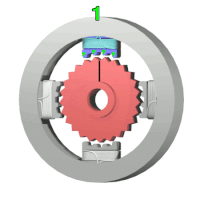
Photo from wikipedia
The rheological characterisation of viscoelastic materials undergoing a sol-gel transition at the Gel Point (GP) has important applications in a wide range of industrial, biological, and clinical environments and can… Click to show full abstract
The rheological characterisation of viscoelastic materials undergoing a sol-gel transition at the Gel Point (GP) has important applications in a wide range of industrial, biological, and clinical environments and can provide information regarding both kinetic and microstructural aspects of gelation. The most rigorous basis for identifying the GP involves exploiting the frequency dependence of the real and imaginary parts of the complex shear modulus of the critical gel (the system at the GP) measured under small amplitude oscillatory shear conditions. This approach to GP identification requires that rheological data be obtained over a range of oscillatory shear frequencies. Such measurements are limited by sample mutation considerations (at low frequencies) and, when experiments are conducted using combined motor-transducer (CMT) rheometers, by instrument inertia considerations (at high frequencies). Together, sample mutation and inertia induced artefacts can lead to significant errors in the determinatio...
Journal Title: Physics of Fluids
Year Published: 2017
Link to full text (if available)
Share on Social Media: Sign Up to like & get
recommendations!